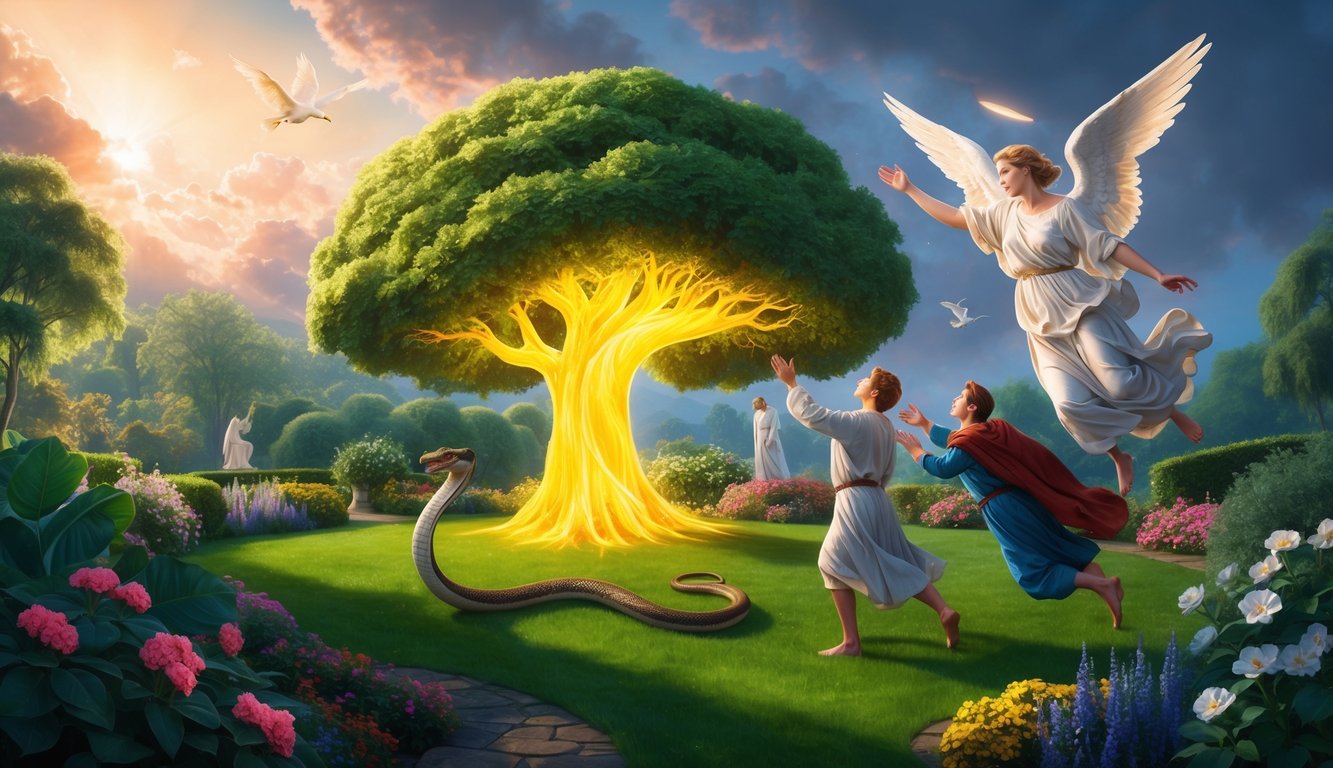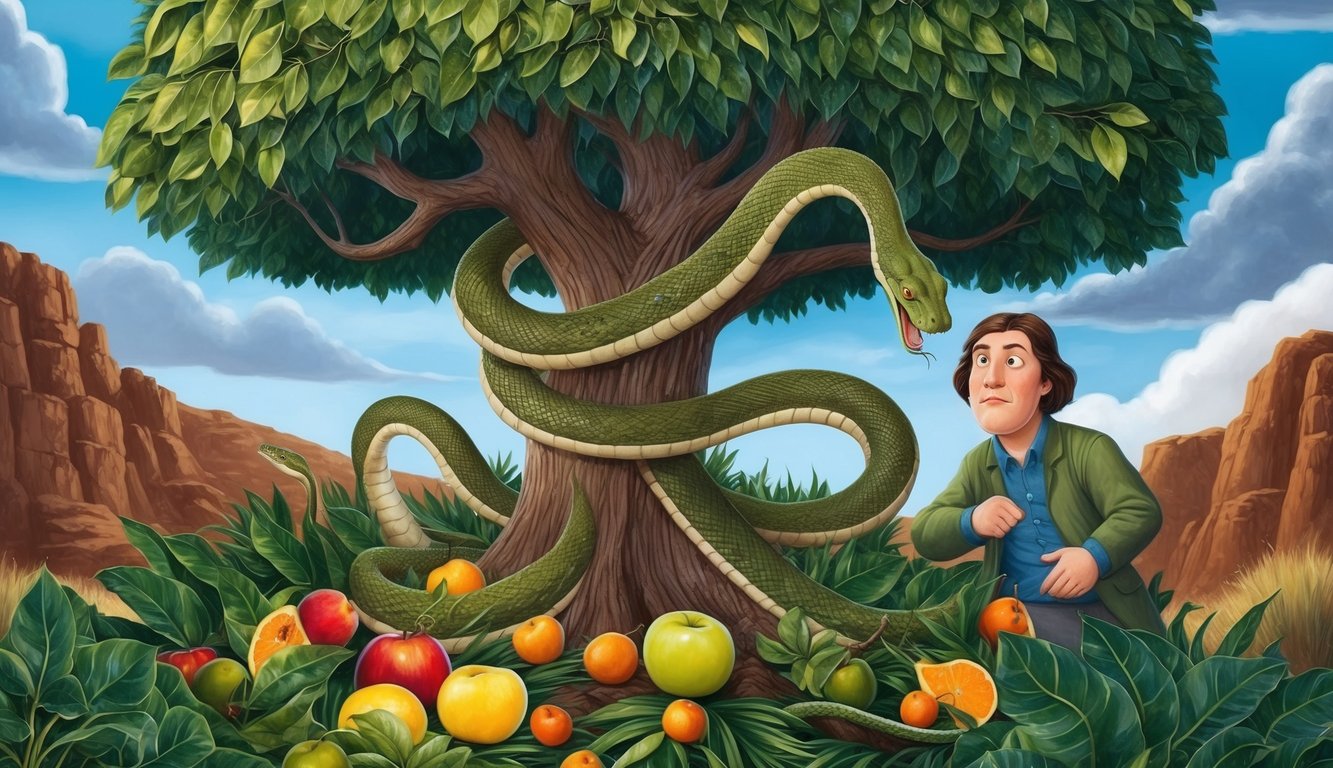Don’t Miss Out On This Unique Astrological Opportunity
Are you tired of spinning your wheels and getting nowhere? Simply put, you’re out of sync: you’re out of alignment with your astral configuration.
But: there’s a kind of map that can help you reclaim your alignment. Think of it as your own personal blueprint to success and happiness: a blueprint that will help you live your most amazing life.
Get started here.
Genesis 3 tells an ancient story that has fascinated people for centuries.
It is a tale about choices, consequences, and human nature.
The chapter begins with a serpent who speaks to Eve.
This crafty creature questions God’s command, and Eve listens.
As she shares the fruit with Adam, they both realize their disobedience and face serious consequences.
This pivotal moment is often referred to as “The Fall.”
The story of Genesis 3 is more than just about Adam and Eve eating forbidden fruit.
It’s filled with rich themes like temptation, guilt, and the struggle between right and wrong.
After they eat the fruit, Adam and Eve feel shame and try to hide from God.
Their actions lead to a world that is changed forever.
You can sense the tension in the story, as God dishes out punishments not only to them but to the serpent as well.
As you explore Genesis 3, you will encounter questions about why things happened the way they did and what it all means for humanity.
The chapter ends with the expulsion from Eden, marking the start of a life that includes suffering and labor.
This story prompts us to think about our own choices and their impacts on ourselves and others.
Key Takeaways
- Genesis 3 explores disobedience and its consequences.
- Adam and Eve face punishments, changing their lives forever.
- The story invites reflection on human choices and morality.
The Fall of Man
In Genesis 3, the story unfolds a pivotal moment for humanity involving temptation, choices, and consequences.
You see the interactions between divine command and human defiance.
The Serpent’s Deception
In the Garden of Eden, a cunning serpent plays a key role.
It approaches the woman, questioning God’s command about not eating from the tree of the knowledge of good and evil.
The serpent plants seeds of doubt, suggesting that eating the fruit would not lead to death, but instead grant wisdom and insight like God.
Its cunning words are persuasive, leading the woman to consider disobeying God’s command.
The serpent’s tactic highlights the power of deceit and temptation, setting the stage for the events that follow.
The Forbidden Fruit
The woman, after being deceived by the serpent, eyes the forbidden fruit.
Enticed by the thought of gaining knowledge, she takes and eats it.
She also gives it to her husband, who is with her, and he eats it too.
This act represents a significant turning point.
The choice to eat the fruit is an act of disobedience towards God’s clear command.
This moment marks a shift from innocence to awareness, opening their eyes to both good and evil.
The decision to eat the fruit is not just about hunger but about a desire for power and wisdom.
The Consequences of Disobedience
Once they have eaten the fruit, the eyes of the woman and her husband are opened.
They realize their nakedness, covering themselves with fig leaves.
God calls to them, asking, “Where are you?” This marks the beginning of their separation from God.
The immediate consequences are shame and fear.
Further, God pronounces judgments on the serpent, the woman, and the man.
Relationships are strained, and the harmony of Eden is lost.
Exiled from the garden, they are barred from the tree of life, ensuring mortality.
This chain of events defines humanity’s struggle with sin and its effects.
The Punishments and Curses
Genesis 3 describes the consequences faced by the serpent, the woman, and the man after the first sin.
Each received specific punishments that changed their lives and the world around them.
Curse on the Serpent
After the deception in the garden, the serpent faced direct punishment.
It was cursed to crawl on its belly and eat dust all its life.
This act symbolized humility and degradation.
Furthermore, God introduced enmity between the serpent and the woman, which extended to their offspring.
The prophecy spoke of the woman’s seed crushing the serpent’s head, while the serpent would bruise her seed’s heel.
This reflects ongoing conflict and struggle between humans and evil forces.
Curse on the Woman
For the woman, the curse brought increased pain during childbirth.
The joy of bringing new life would now involve intense physical pain.
This change highlighted the severity of Eve’s actions.
In addition to pain, the woman experienced changes in her relationship with the man.
Her desire would be for her husband, yet he would rule over her.
This shift affected family dynamics, indicating a new power balance and the challenges within human relationships.
Curse on the Man
The curse on the man affected his relationship with the ground.
God told Adam that the ground was cursed because of his actions.
As a result, he would face toil and sweat to produce food.
The once-fertile ground would now bring forth thorns and thistles, making farming laborious.
This hardship reflected the struggle against nature, as Adam had to work for sustenance.
The curse emphasized the consequences of disobedience, impacting human existence and their bond with the earth.
The Expulsion from Eden

The Expulsion from Eden involves Adam and Eve facing the consequences of their actions.
After eating from the tree of knowledge, they experience profound changes and are ultimately removed from the Garden of Eden.
Garments of Skin
When you think of Adam and Eve in the Garden of Eden, one vivid image might be their use of fig leaves to cover themselves.
After they ate the forbidden fruit, their eyes were opened, and they realized they were naked and felt afraid and ashamed.
In a gesture of care, God made garments of skin to clothe them.
These garments served as a tangible reminder of their newfound knowledge and the changes they faced.
Wearing clothing was a new experience for them, marking a shift from innocence to awareness.
Providing these garments was also an act of preparation for life outside the garden, where they could no longer rely on the perfect conditions they once enjoyed.
This moment shows a blend of judgment and compassion, setting the stage for their departure.
Banishment from the Garden
Adam and Eve’s decision to eat from the tree led to their banishment from Eden.
You might wonder why such a harsh step was necessary.
God decided they couldn’t stay in the garden because they now understood good and evil.
Remaining there meant they might also eat from the tree of life and live forever, a situation that couldn’t happen now that they were aware of sin.
Banishing them was more than just punishment; it was about ensuring that their new life reflected the complexities of their choices.
They were sent to work the land from which Adam was originally formed, indicating a return to basics, where they would toil and labor outside of paradise.
This transition from bliss to struggle was significant in human history according to the story.
The act of banishment transformed their lives, shifting them into a new phase of existence.
Guarding the Tree of Life
You might envision the daunting scene at the edge of Eden.
Here, God placed Cherubim, along with a flaming sword that moved in all directions.
This effective barrier protected the way to the tree of life, ensuring no return to the garden.
This vivid imagery highlights the seriousness of the expulsion and the importance of leaving the past behind.
The Cherubim symbolize divine guardianship, showing that access to eternal life was no longer available.
The flaming sword’s presence underscored the irreversible change in their status.
It was both a literal and symbolic closure to their time in paradise.
This measure illustrates how actions have long-lasting consequences.
The guard set before the tree serves as a permanent reminder of the choices made and the new world now in place for humanity.
Frequently Asked Questions

Genesis Chapter 3 tells the story of the fall of man, highlighting the choices of Adam and Eve, the consequences of their disobedience, and the introduction of sin.
This chapter also examines themes like temptation, divine justice, and the impacts of translation differences on understanding the scripture.
Their actions led to their expulsion from the Garden of Eden, marking a turning point in humanity’s relationship with God.
This narrative sets the stage for later biblical stories, including discussions on sin, redemption, and divine intervention.
Some scholars draw connections between this chapter and Genesis 6 ancient mysteries, which explore themes of human transgression and the consequences of straying from divine commands.
What is the main point of Genesis Chapter 3?
Genesis Chapter 3 is about Adam and Eve eating the forbidden fruit, which leads to the fall of man.
Their actions introduce sin and disobedience into the world, changing their relationship with God.
This chapter highlights themes of temptation and the consequences of human choices.
Which verse in Genesis Chapter 3 holds significant importance, and why?
Genesis 3:15 is key because it foretells the struggle between good and evil.
The verse is seen as the first gospel, hinting at future redemption and the ultimate victory of Christ over sin.
It speaks of enmity between the serpent and the offspring of the woman.
Can you explain the enmity between the woman and the serpent mentioned in Genesis 3?
The enmity between the woman and the serpent refers to the ongoing conflict between humanity and evil.
It symbolizes the struggle between good and evil throughout history.
Many see this as a prophecy pointing to the future defeat of sin through Jesus.
What does Genesis 3:1-13 signify in the context of the scripture?
Genesis 3:1-13 tells the story of temptation and the first sin.
It describes the serpent tempting Eve and her sharing the fruit with Adam.
These verses show how sin enters the world, highlighting themes of temptation, choice, and human weakness.
How do different Bible translations impact the understanding of Genesis 3?
Different Bible translations can affect your understanding by altering the words and phrasing.
For instance, choice of words can impact the interpretation of sin, judgment, and redemption.
Variations may lead to different theological insights or emphases on specific aspects of the story.
What are the consequences of Adam and Eve’s actions in Genesis 3 according to biblical commentary?
The consequences of Adam and Eve’s actions include being banished from Eden and experiencing pain and toil.
Their disobedience introduces sin into the world, affecting all of humanity.
Commentaries discuss themes of divine justice and the human condition, emphasizing separation from God and the struggles that follow.



